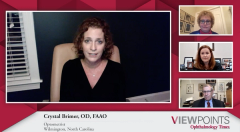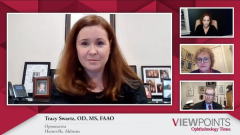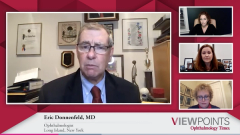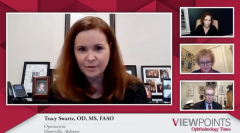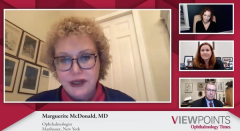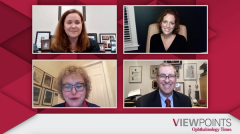
Corticosteroids and Immunomodulators for the treatment of dry eye
Episodes in this series

Marguerite McDonald, MD: Eric, back to you, we’re going to talk about the role of treatment options for dry eye management. Let’s start with anti-inflammatory agents. When do you prescribe them, and do you have a preference for a particular agent?
Eric Donnenfeld, MD: Anti-inflammatory agents are very important in the management of dry eye, and that’s really been the change in therapy that’s really revolutionized dry eye. Twenty years ago, dry eye was the back pain of eye care. Patients complained about it and you really couldn’t do much about it. The revolution occurred almost 20 years ago with the use of Restasis and the idea that cyclosporine could play a significant role in treating dry eye. We’ve now had other immunomodulators that have come forward. We have lifitegrast, which is a very potent immunomodulator, we have different concentrations of cyclosporine coming, and now for the first time we also have FDA-approved corticosteroids for the treatment of dry eye disease. We know that steroids and immunomodulators play a very significant role in dry eye, and they are very effective. They’re very safe if you’re talking about lifitegrast and cyclosporine, and very effective if you’re talking about corticosteroids.
I like to initiate therapy early on. When I talk to patients who come in with dry eye, I tell them you have a disease and you have 2 treatment options. We can treat your symptoms, or we can treat the disease itself. Lubricants treat the symptoms. Immunomodulators treat the disease process. If I was a patient and I was given the option of actually treating the disease, I’d want my disease treated rather than my symptoms. I think immunomodulators play a very significant role and continue to be significantly underutilized. I think there’s a lot of role for combining immunomodulation with a corticosteroid and a cyclosporine or lifitegrast, and I think using both of them together is a very effective way of initiating therapy.
Marguerite McDonald, MD: Terrific. Do you ever initiate the immunomodulatory agent with a short run in of a topical corticosteroid?
Eric Donnenfeld, MD: Marguerite, that’s become my go-to therapy. This is done in all of medicine, you start on a steroid and you use the immunomodulation, and we in ophthalmology and optometry are doing exactly the same thing. The steroids work more rapidly, they reduce the secondary adverse effects of burning and irritation and foreign body sensation. I think there’s a synergy working together with them. Then we run in the steroids for maybe a month or so, and then are able to taper off and maintain the patient very commonly on just the nonsteroid immunomodulator.
Now, patients also get flare-ups, and that’s the nature of dry eye. It’s not a stagnant disease. You don’t get dry eye and it doesn’t stay off a plateau the entire year. We have these flares where it goes up and down. I think that the approval of loteprednol 0.25% for dry eye flares is a really significant advance in the management of dry eye, because it allows us to do a short-term therapy to really treat those patients who really have intermittent dry eye, where they become very symptomatic over time. I know for me, when I go out west and I go skiing at 10,000 feet, my dry eye becomes very significant. Most of the day at home, at sea level, it doesn’t really bother me. So to answer your question, I think the use of steroids and immunomodulators like cyclosporine or lifitegrast are really crucial to the management of dry eye.
Marguerite McDonald, MD, Eric Donnenfeld, MD, Tracy Swartz, OD, MS, FAAO, and Crystal Brimer, OD, FAAO, discuss a number of topics pertaining to dry eye, including the diagnosis and clinical manifestations, traditional, treatment options, and the potential new agents in the horizon.
Newsletter
Don’t miss out—get Ophthalmology Times updates on the latest clinical advancements and expert interviews, straight to your inbox.




